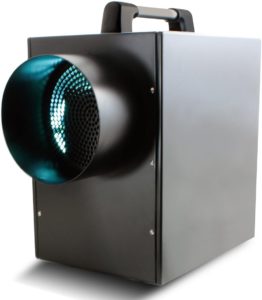
While most are aware of the use of the ozone generator in remediation and renovation work, using a hydroxyl generator is another lesser-known option.
The two devices have many similarities, and a few stand-outs differences. As far as remediation work goes, hydroxyl generators are effective at removing odors from the air as well as killing mold spores that are airborne. But, there’s much more to it than that.
Related: See our pick for best Hydroxyl Generator for odor removal.
What is hydroxyl?
Hydroxy or a hydroxyl group is a radical that is composed of one hydrogen atom and one oxygen atom. Hydroxyl radicals are naturally occurring, created when the sun’s ultraviolet rays (UV rays) reach with water vapor. Hydroxyl radicals actually play an important role in ridding our atmosphere from harmful compounds.
What does a hydroxyl generator do?
Hydroxyl generators are used to kill mold and odors from indoor spaces. The are popular in both restoration and remediation work as hydroxyl generators are allow safe use while the space is occupied. Using the same UV radiation that occurs naturally, hydroxyl generators naturally deodorize indoor environments.
Even though they are safe for use in areas occupied by people, their use is almost exclusively commercial in nature.
Applications
Hydroxyl generators are used for much of the same work that their ozone counterparts are used.
Mold Remediation
Renovation and remediation workers use hydroxyl generators alongside air scrubbers and commercial dehumidifiers to remove mold spores from the air.
Odor Removal
Hydroxyl generators excel at odor removal from indoor spaces. Odors are removed by altering their chemical composition. Whether smoke or other offending odor, a hydroxyl generator is a very safe alternative to ozone.
How do hydroxyl generators work?
In layman’s terms, a hydroxyl generator takes in ambient air, treats it using hydroxyl radicals, then exhausts the purified air. The cleaned air is usually returned to the same room although some Hydroxyl Generators are easily ducted, allowing the air to be sent elsewhere.
Treatment with hydroxyl radicals is similar to treating air with ozone in that it breaks down odors and pathogens by changing their composition. Hydroxyl is actually far more reactive than ozone, being over a million times more reactive. This dramatic increase in reactivity allow a Hydroxyl Generator to treat a wider variety of odors.
Comparing ozone and hydroxyl generators
While both hydroxyl generators and ozone generators seem very similar, there are notable differences.
- Hydroxyl generators are safe to use in occupied, enclosed spaces where ozone generators are not
- A hydroxyl generator takes longer to remove odors than an ozone generator
- Ozone generators can damage sensitive materials in indoor spaces whereas hydroxyl generators won’t damage sensitive materials
Use in renovation and remediation work
Hydroxyl generators…
- Destroy odors as opposed to covering them up
- Kill airborne mold spores
Hydroxyl generators do not…
- Kill surface mold
- Damage surfaces or electronics, nor will they discolor items that are wet.
Related
- Best Hydroxyl Generators to Buy 2021
